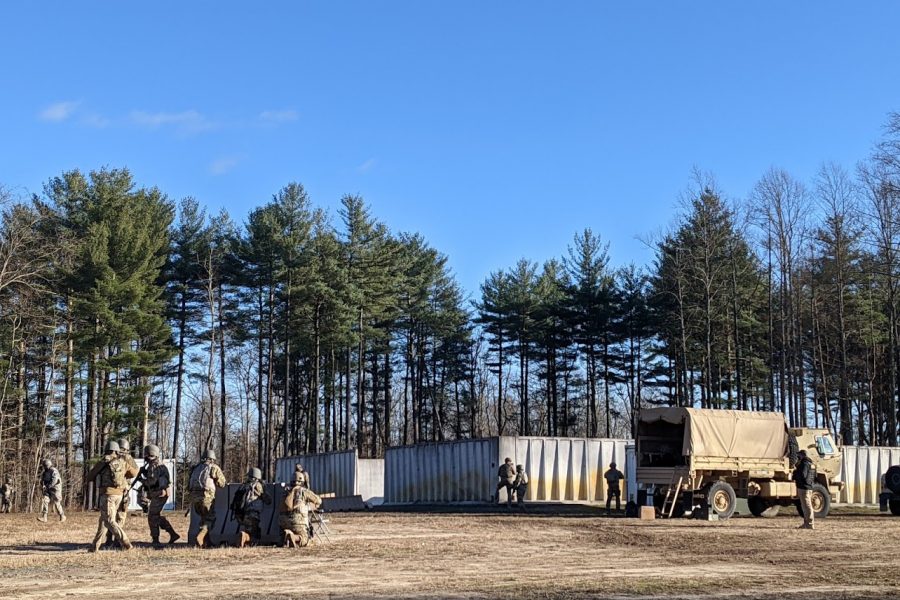JOINT BASE MCGUIRE-DIX-LAKEHURST, N.J.—When the coronavirus pandemic hit the U.S. and much of the country entered lockdown earlier this year, the Air Force still needed to deploy with ready Airmen.
That posed a challenge for the Air Force Expeditionary Center here: How could the Expeditionary Operations School and the 421st Combat Training Squadron take on the growing demand for prepared Airmen while keeping people safe?
“The expeditionary mission never went away,” Maj. Gen. Mark D. Camerer, commander of the Expeditionary Center, said in a Dec. 8 interview here.
“We were actually here working more hours” to figure out how to get incoming students whose deployment orders hadn’t changed “the training they needed so they can be effective downrange, while keeping them COVID-safe,” he said.
The Expeditionary Operations School is tasked with training Airmen with combat skills as they head to austere locations in the Middle East and Africa. It also handles air advisers, Phoenix Raven security forces, and contingency response Airmen. About 10,000 students go through the schoolhouse each year, where the 421st CTS and 423rd Mobility Training Squadron oversee training.
The number of Airmen told to take the training was already on the rise when COVID-19 hit, as it’s now required for all Airmen going to Africa to have combat training. The Defense Department restricted personnel travel around the globe, but that didn’t affect pre-deployment training. The 421st CTS paused for about two weeks to rewrite lessons and find ways to spread out its students in line with social-distancing guidelines.
“We had to compare every job qualification standard and every advanced deployment requirement pre-COVID with what we could continue to do safely and effectively in order to meet theater entry requirements,” said Tech. Sgt. Justin Wadekamper, 421st CTS contingency response course director, in a release earlier this year.
At first, students had to quarantine for 14 days in on-base lodging before the training course. Airmen took some computer classes and did some physical training, and the USO and American Red Cross donated books, puzzles, and snacks while they were stuck inside.
Now, the quarantine is no longer a requirement. Camerer said they test people for the virus before they arrive and once they get to the school instead.
“As we’ve learned about the disease, and we’ve learned about how it spreads, we’ve adjusted what we do to stay relevant,” said Camerer, who took command in September.
Some Airmen were able to waive training if they completed it in recent years. Courses that typically involved about 200 members were broken down to small bubbles. If an Airman in a bubble comes down with COVID-19, it’s easier to monitor that limited group. Cleaning ramped up, and Airmen have to wear masks when indoors.
The school changed its schedule from 14 days in class, including weekends off, to 10 days straight with no days off.
“As we come up on this holiday, it will literally be the first deep breath of about 11 days in a row,” Camerer said. “I think we’re going to slow down operations to almost nothing and … and take a break.”
The pre-deployment expeditionary skills training run by the 421st CTS includes lessons on dealing with active-shooter scenarios, weapons, self-administered medical aid, battlefield movement, improvised explosive devices, and more. Training is tailored to whether Airmen are heading into hostile or uncertain environments.
The goal is to give Airmen who typically don’t expect to encounter an attack outside the wire a baseline of training to fall back on and stay calm—though, hopefully, they never need it.
On a recent chilly day, Air Force Magazine worked through a training scenario with a team of Airmen in several professions, ranging from finance to maintenance. The Airmen in the cohort moved through a “village” just off the McGuire-Dix-Lakehurst flight line, where they encountered simulated mortar fire and friendly and hostile checkpoints. The group also confronted a mock tribal leader in an engagement that spiraled out of control when blanks from AK-47s started firing.
The training is reminiscent of years of outside-the-wire interactions in Afghanistan—only now with face masks.
“The Airmen here at this schoolhouse worked overtime to make sure we can still produce what our combatant commanders required downrange,” Camerer said.
